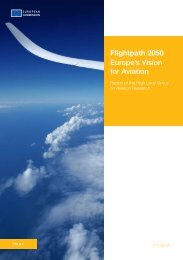Create
Final Report - Acare
Final Report - Acare
- No tags were found...
Create successful ePaper yourself
Turn your PDF publications into a flip-book with our unique Google optimized e-Paper software.
THE NEED<br />
for innovation<br />
II.<br />
It is just as well that everything does not<br />
need to be accomplished at once. We do<br />
not yet have a series of well developed and<br />
thoroughly investigated solutions. We now<br />
need to start the establishment of a number<br />
of conceptual ideas for future operations that<br />
have been given a chance to start on the road<br />
towards becoming candidates for the future<br />
system components or concepts.<br />
If conceptual ideas for the future are to<br />
be developed progressively and stand as<br />
candidates from which choices can be made<br />
in later years it is clear that they must be<br />
allowed to be grown. Every innovatory<br />
change must be preceded by study – and this<br />
most certainly will be true of the aviation<br />
sector. However, there are serious obstacles to<br />
getting such studies moving. There is a lack<br />
of an adequate system of investment in such<br />
ideas. Secondly, due to financial pressure for<br />
short term return on investment, there is a<br />
reluctance on the part of the enterprises of<br />
aviation to invest today’s money in particular<br />
concepts and, since they cannot work on<br />
them all, this implies choosing winners which<br />
is well known to be usually foolhardy.<br />
What are the characteristics of a process that<br />
would allow a portfolio of new and perhaps<br />
radical ideas to be studied for possible future<br />
use?<br />
Building on the thoughts above we can see<br />
that the system must allow for several issues<br />
to be resolved:<br />
(a) Stimulating and encouraging the<br />
formulation of ideas for the future.<br />
(b) Providing a structure of review, assessment<br />
and down-selection.<br />
(c) Providing funding for the progressive derisking<br />
of the most favoured, interesting<br />
and potentially important concepts<br />
through exploratory research and study.<br />
(d) Protecting that funding from premature<br />
re-evaluation and change before the idea<br />
has been adequately examined.<br />
(e) Engaging the progressive attention of<br />
the industries concerned as the ideas are<br />
developed.<br />
(f) Providing for the progressive transfer<br />
of IPR and funding responsibility from<br />
a collective endeavour to individual<br />
industrial enterprises.<br />
This is the challenge that is addressed by the<br />
evolution of the CREATE process.<br />
4. A Concept for Innovation<br />
4.1. The aim of the CREATE<br />
approach<br />
In addressing the challenges set out above,<br />
CREATE has refined the scope of its ambition. It<br />
has, from the outset aimed to be a system for<br />
Europe. This is at once such a simple aim and a<br />
complex issue that its implications are set out in<br />
section 4.3. below. Nevertheless, developing a<br />
system for Europe was the CREATE project aim.<br />
It was also an aim from the earliest days to<br />
concentrate particularly on the areas that<br />
were not provided for at present. It was never,<br />
therefore, an aim of the CREATE project to<br />
cover the entire span of innovation. Some<br />
areas of innovation are perfectly feasible<br />
within present arrangements. For example:<br />
companies in Europe and elsewhere can<br />
and do invest in innovative new materials<br />
and components for their existing products<br />
and it is entirely appropriate, and necessary<br />
that they should do so. The area that is a<br />
particular focus for the CREATE process is in<br />
the area mentioned above; large scale systems<br />
innovations with the potential to change the<br />
concept of the air transport industry.<br />
HIGH<br />
RISK<br />
LOW<br />
LOW<br />
Will not be done<br />
Low benefit<br />
High risk<br />
May be done<br />
Low Benefit<br />
Low Risk<br />
BENEFITS<br />
Vectors<br />
of Risk & Benefit<br />
Fig.1. The CREATE target area<br />
The CREATE<br />
Direction<br />
Will be done<br />
High Benefit<br />
Low Risk<br />
HIGH<br />
Getting good ideas relevant to the focus into<br />
the mainstream of research programmes<br />
has been the primary aim in developing the<br />
CREATE process. Key to that achievement<br />
will be identifying and developing the most<br />
promising ideas and building them to a level<br />
of credibility that will allow them to compete<br />
for support in the mainstream. Identifying<br />
which are the ‘most promising’ implies a<br />
17



